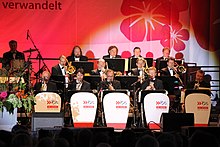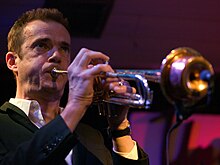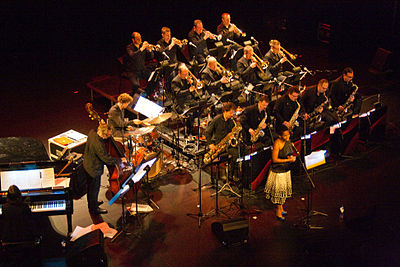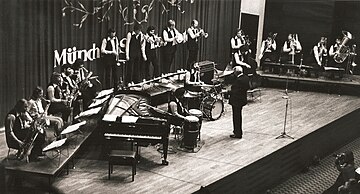Big Band
A big band or big band (formerly often Jazz Orchestra is called) a great jazz - band with multi-occupied wind instruments and the so-called rhythm section. Big bands emerged in the USA in the 1920s and shaped the style of the swing era. The term is also used generally for large dance orchestras , regardless of their style.
Occupations
Swing or jazz big band

In the Big Band, the parts of the various individual instruments of early jazz ( New Orleans Jazz ) were originally assigned to larger sections, that is, groups of similar instruments. The standard sections of a modern big band are:
- Rhythm group (percussion section) : piano / keyboard, guitar , double or electric bass (also tuba ), drums and other percussion instruments ,
- Woodwinds (reed section) : saxophones , sometimessupplemented or completely replacedby clarinets * / bass clarinet * or flutes / alto flutes ,
- Brass section : trumpets * and trombones .
* usually tuned in B.
Each wind section is usually made up of four to five instruments of the respective group, which are graded according to the maximum playable (or arranged according to the arrangement) pitch:
- Saxophones: 1st, 2nd alto saxophone ; 1st, 2nd tenor saxophone ; Baritone saxophone (secondary instruments: soprano saxophone , transverse flute / alto flute, clarinet / bass clarinet)
- Trumpets 1st to 4th (occasionally 5th) trumpet (secondary instruments: flugelhorn ; piccolo trumpet for extremely high parts )
- Trumpets: 1st to 4th trombone , 4th usually bass trombone. (5 trumpets are rather unusual)
The first voices take over the leading or lead part of their section, as well as mostly all the solos. In tutti or shout phrases, the first trumpet is usually the lead voice as the highest and most penetrating instrument.
Until the 1960s, dance orchestras were common in which a big band formation was combined with a string ensemble (violins, violas, cellos - no double basses), even if, in contrast to the strings in the symphony orchestra, these often do not play the entire piece or can be used much more selectively. Other instruments that originally came from classical orchestral literature are also occasionally included. So z. B. harp, horns, oboe / English horn or timpani. The bass register is also seldom reinforced with tuba or bassoon. However, in contrast to the above (almost always similar) rhythm and wind section, none of these additions are part of the standard formation. As already mentioned, the alto and tenor saxophonists often switch to the flute or clarinet, but sometimes the saxophone parts also remain and there are independent flutists and / or clarinetists. With these supplementary options, the transition from a big band to a more symphonic ensemble (or even orchestra) can be fluid.
The sound of the ensemble is largely determined by the arranger , who has to know the possible voice guidance and the technical possibilities of the big band instruments and instrumentalists very precisely in order to create the desired overall sound as effectively as possible.
Mambo big band
A special form of the Big Band is the Mambo Big Band , a large ensemble of musicians who specialize in the Mambo .
A typical Mambo big band consists of:
- Rhythm group :
- Brass :
-
Woodwinds
- 2–5 saxophones (alto, tenor, baritone saxophone)
- possibly flutes and / or clarinets
All instruments - with the exception of piano, guitar, bass and drums - are always multi-staffed. Often there are several singers, usually consisting of a soloist and an accompanying group. Occasionally, other instruments such as the vibraphone are used.
In contrast to the classic jazz big band, the focus here is on the rhythm section, while woodwinds are neglected in return. In the brass section, the trombones play a subordinate role.
Accordion big band
Another version of the big band is the accordion big band , a big band in which the accordion takes on the role of the actual wind instruments.
A typical accordion big band consists of:
-
Accordion section in 3-4 voices :
- 2–4 accordions per part
- Rhythm group :
-
Other optional instruments:
- Wind instruments as solo instruments (e.g. saxophone , trombone , trumpet )
- singing
- Percussion
- Keyboards for effects or to imitate rare instruments
The accordion big band has evolved from the form of the accordion orchestra since the late 1980s . It differs from the accordion orchestra on the one hand by style and repertoire, but above all by the consistent use of a classical rhythm section: Instead of a bass accordion and a voice that mainly accompanies with chords, a double bass or electric bass is accompanied by a piano or guitar used. As a rule, existing arrangements from the accordion or big band literature have to be adapted.
Since the accordion is closely related to (actual) wind instruments because of its sound generation principle of the penetrating tongue , comparable dynamic effects can be achieved in particular. To by the possibility of the instruments / voices individually register , various "traditional" instrument groups can be imitated sound (strings, brass or woodwinds, s. O.). Since one instrument can be played with several voices, you are not limited to three-part movements when using three groups of voices.
Style-defining original literature and transfers for accordion big bands were shaped in particular by the accordion composers Hans-Günter Kölz and Wolfgang Ruß-Plötz.
Specific sound characteristics and composition techniques
Many pieces of big band music are largely based on the jazz harmonic that formed in the swing era. However, there are also big band arrangements or compositions, for example from pop or Latin American music, which can follow other harmonic principles than those of jazz, or are only partially based on jazz harmony.
In addition to the specific harmonic and melodic peculiarities typical of Swing, numerous “modern” techniques are used in big band music, especially with the wind instruments, which are rarely heard in classical, conservative music. To be mentioned here are mainly:
- Case: a down-glissing figure (usually without a fixed target grade)
- Doit: an up-glissanding figure (usually without a fixed target grade)
- Bend: moving up and down on a sustained note
- Scoop / Slide-in: sliding into a fixed target grade (usually from below)
- Rip: a mostly played forte, glissanding figure far from bottom to top in a given target note
- Glissando / Portamento: longer gliding from a fixed starting note to a fixed target note
- Shake: a “wilder” variant of the classic trill
- Flutter tongue: a kind of tremolo on a wind instrument that is created by the player's tongue rolling
- Growls: a rather rough, boisterous sound that is created by a more complex combination of several techniques in the brass section
There are several different types of notation for these varieties. For glissanding techniques (fall, doit, scoop, bend, rip), a descending or ascending undulating or straight glissando line, but sometimes also a tie, is drawn in, while other techniques (such as shake, flutter tongue or growl) are also drawn by the arranger often (additionally) the name of the performance to be performed is written over the corresponding notes.
In addition, in general in jazz and thus also in big band literature, the range of trumpets is sometimes pushed to the extreme, which is generally not the case in classical serious music. The first trumpet in particular sometimes plays up to the three-bowed g or, depending on the player's expertise, even higher. Another special technique is the subtone technique of the saxophone.
Use of dampers

In big band music, brass players (trumpets and trombones) also like to use numerous types of mutes , e.g. B. Straight , Harmon , Cup , Plunger , Bucket or Pixiemute. The choice of damper can significantly change the timbre and effect of the sound. So z. For example, an attached harmon mute without a “stem” on the trumpet produces the sharp, nasal “Miles Davis sound” and the harmon mute with an additional “stem” plays the typical “ wah-wah ” sound, which is often a humorous sound Sound effects is used, while the bucket or cup mutes significantly reduce the sound and radiance of the sheet metal and provide a rather dull, veiled sound, which z. B. can be better adapted to the overall sound of a quieter arrangement with flutes and clarinets instead of saxophones. Straight mutes are also popular because they produce a sharp and focused sound.
As an alternative to playing with the damper or if this is not available, you can also play " in stand" . The horn of the instrument is held directly in front of the music stand, which reduces the general radiance of the sound.
Extremely high position

Another typical fact in many big band arrangements is the requirement of very high parts for the first trumpet. In contrast to trumpeters in classical symphony orchestras, who (when using an ordinary Bb trumpet) usually, at least with first trumpeters with a high level of expertise, tones up to approximately c '' '(notated) or in extreme cases e' '' (notated ) can be expected, jazz trumpeters sometimes expect tones up to g '' '(notated) or even higher tones. With such high notes the result is a very penetrating sound, especially when played in fortissimo, which is able to cut through the rest of the big band (for longer passages, which also take place in a very high register, the B- Trumpet can be changed to piccolo trumpet ).
An example for sometimes extremely high trumpet parts would be z. B. Michael Bubble's arrangement for the Jazz Standard Feeling Good , here the first trumpet shoots up to the four-bowed c (c '' '').
Score image
The score also differs from classical music, because in contrast to the latter, in which the brass parts in particular are usually categorized as trumpet 1-2, trumpet 3-4, etc., in big band literature a complete one is also made for each individual instrument part own system used (i.e. trumpet 1, trumpet 2 etc.).
In contrast to smaller jazz ensembles, in which the instruments are often arranged in the range from top to bottom (e.g. from top to bottom; trumpet - tenor sax. - trombone - piano - bass - drums), the instruments are graded a big band score standardized according to the scheme (from top to bottom) saxophones, trumpets, trombones, rhythm group.
Well-known representatives
In contemporary Europe, the Pasadena Roof Orchestra is an authentic representative of the genre of “white ballroom music” in the style of Paul Whiteman or Glen Gray's Casa Loma Orchestra . The first big band swing arrangements can be heard in the recordings of the Fletcher Henderson Orchestra. Fletcher Henderson has perfected this style of arranging for the Benny Goodman Big Band over the years . In terms of sound, the musicians of the Duke Ellington Orchestra , whose compositions and arrangements are authentic for sound and jazz in the big band, should be mentioned in particular . Count Basie's Big Band set the standards of modern big band music and was characterized above all by the groove of the rhythm section. Earl Hines and His Orchestra was the nucleus of bebop in 1943 ; the resulting Billy Eckstine Orchestra integrated harmonies of the new bebop; Stan Kenton introduced symphonic timbres.
The short-lived Quincy Jones Big Band caused a sensation in Europe in 1959/60 with their free-and-easy tour . What was unusual in the 1960s was the Kenny Clarke / Francy Boland Big Band , which was based in Europe but largely consisted of African Americans, and had two band leaders (Clarke was the drummer and Boland pianist and arranger) and two drummers (the African American Kenny Clarke and the white British Kenny Clare ). Sun Ra and his Arkestra and the Globe Unity Orchestra have been active in the field of free jazz since the mid-1960s ; and Jef Gilson and Chris McGregor and his Brotherhood of Breath respect the free play in the big band work a.
In the 1970s there were big band projects by Charles Mingus ( Let My Children Hear Music ) and Charles Tolliver or The George Gruntz Concert Jazz Band with numerous US and European guest soloists. Gil Evans had his unusually cast production The Gil Evans Orchestra Plays the Music of Jimi Hendrix followed in the 1980s by The Monday Night Orchestra .
A well-known representative of the mambo big band genre was the band of Pérez Prado , who successfully won the Mambo No. 5 published. Today the Palladium Night Orchestra follows the tradition of the bands of Machito , Tito Puente and Tito Rodríguez who made the Mambo famous in the Palladium on Broadway in New York City in the 1950s .
In addition to dance and light music, radio or television music was often the job of a big band until the 1980s. The music developed away from the roots of jazz, from which the (free and “wild”) improvisation then almost completely disappeared. Many bands were disbanded in the 1980s due to inefficiency, such as the New York Thad Jones / Mel Lewis Orchestra .
Today's big band repertoire ranges from old jazz to upscale entertainment and dance music, but also to new, comprehensive interpretations and full-length concert works due to the diversity of the line-up. Contemporary big bands that combine old traditions with new developments are e.g. Today, for example, the NDR Big Band , the WDR Big Band , but also the Jazz at Lincoln Center Orchestra under the direction of Wynton Marsalis , which is dedicated to maintaining the classical repertoire and techniques from the early days of jazz development.
Improvisations
As a rule, big band arrangements offer space for solo improvisations, in which a player from one of the sections improvises and the rhythm section of the big band accompanies the improviser. If necessary, the improvisation is accompanied by voices from the sections. Collective improvisations , such as those found in Dixieland ensembles, are very rarely provided.
Well-known big band leader
Big bands are often inextricably linked with the name of their band leader . The better known include:
- Toshiko Akiyoshi / Lew Tabackin
- Count Basie ( Count Basie Orchestra )
- Dajos Béla
- Carla Bley
- Bob Crosby
- Jimmy Dorsey
- Tommy Dorsey
- Billy Eckstine ( Billy Eckstine and His Orchestra )
- Kurt Edelhagen
- Duke Ellington ( Duke Ellington Orchestra )
- Don Ellis
- Gil Evans ( The Monday Night Orchestra )
- Dani Felber
- Shep Fields
- Dizzy Gillespie ( Dizzy Gillespie Big Band )
- Paul Godwin
- Benny Goodman
- Gordon Goodwin
- Max Greger
- George Gruntz ( The George Gruntz Concert Jazz Band )
- Klaus Hallen
- Fletcher Henderson
- Peter Herbolzheimer
- Woody Herman ( Woody Herman and His Orchestra )
- Earl Hines ( Earl Hines and His Orchestra )
- Ernst van't Hoff
- Bill Holman
- Horst Jankowski
- Quincy Jones ( Quincy Jones Big Band )
- Thad Jones ( Thad Jones / Mel Lewis Orchestra )
- Bert Kaempfert
- Stan Kenton
- Karel Krautgartner
- Gene Krupa ( Gene Krupa and His Orchestra )
- Paul Kuhn ( SFB Big Band )
- James Last
- Erwin Lehn
- Pepe Lienhard
- Jay McShann
- Glenn Miller
- Werner Müller
- Gerry Mulligan ( The Gerry Mulligan Concert Jazz Band )
- Günter Noris
- George Olsen
- Hazy Osterwald
- Buddy Rich ( Buddy Rich Big Band )
- Max hull
- Eddie Sauter ( Sauter-Finegan Orchestra )
- Efim chess master
- Maria Schneider
- Brian Setzer
- Artie Shaw
- Hugo Strasser
- Lothar Stuckart
- Chick Webb
- Kurt Widmann
- Dick Willebrandts
- Thilo Wolf
literature
- George T. Simon: The Golden Era of Big Bands . Hannibal, Höfen / Austria 2004 (original 1981), ISBN 3-85445-243-8 .
Web links
- Directory of German big bands
- Big band history - The famous big bands (PDF; 419 kB)
- Online score management program for big bands
- Carlos Albrecht, The Charm of the Big Band (TMI 2001 V)
- Bundesbigbandarchiv (bbA) non-commercial online music portal
Individual evidence
- ↑ Occasionally one still encounters such formations as the Dutch metropolis Orkest .
- ↑ thesmileybee: Seth MacFarlane - The Sadder But Wiser Girl. October 19, 2011, accessed April 1, 2016 .
- ↑ Do nothing till you hear from me. Retrieved April 3, 2016 .
- ↑ Beyond The Sea. Retrieved April 2, 2016 .
- ^ Elisa Koehler: A Dictionary for the Modern Trumpet Player. Scarecrow Press, 2015, ISBN 978-0-810-88658-2 , p. 117 ( limited preview in Google Book Search).
- ↑ Michael Bublé's lead trumpeter Jumaane Smith in an interview. In: TrumpetScout. January 4, 2015, accessed on August 12, 2020 (German).
- ↑ David Brent Johnson: That '70s Swing: Big Bands And Bell Bottoms in NPR Jazz



